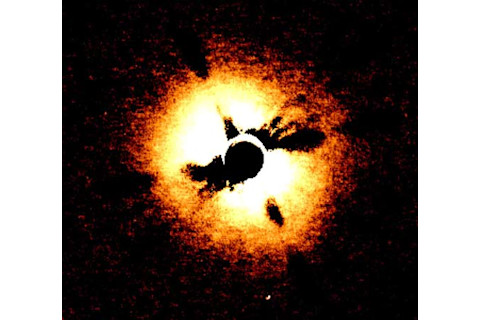File this under "Hey, that's kinda cool": astronomers have found the least massive disk ever around a star. This press release is nifty, but has a major d'oh! moment for me. Read on.

Stars form in different ways, but the final birth pangs are roughly the same for everyone. A flattened disk of material forms from a collapsing cloud of gas and dust. The center heats up as more material piles on, eventually reaching high enough temperatures and densities to ignite nuclear fusion. A star is born. The disk of material around the star can form planets. The types of planets that form vary depending on the type of star, whether it's a binary star, how fast the big planets form, what the material is in the disk, and about a hundred other things. A few years ago this was conjecture, but now it's a solid fact: we see these disks around many young stars. A team of Japanese astronomers pointed the massive 8.2 meter Subaru telescope at the star FN Tau, which is known to be young. It's also a dinky star, classified as an M5, making it a red dwarf (about 0.2 times the Sun's mass). The astronomers looked in the infrared, where a warm disk is bright, and directly detected the disk. They had to block the light from the star (which is overwhelmingly bright), too. What they saw is the picture posted above (click to embiggen). The black splotches are due to the telescope and the coronagraph, the device used to block the starlight. The disk is obvious enough. It's big in human terms, with a diameter 260 times the Earth-Sun distance (Neptune is about 30 times that distance, so this disk is more than 8 times bigger than the solar system). However, as disks go, that's rather small. In fact, the estimated mass (6% of the star's mass, or about 1% of the Sun's mass) makes it the smallest protoplanetary disk ever directly detected. That's cool. However, I do have an issue with the press release. First, there's a claim that I think is not true: it says this is the lowest mass disk around the lowest mass star ever seen. However, in 2005 a disk was detected around a brown dwarf star
, which has far lower mass than FN Tau. It might be the lowest mass star for which a disk is directly detected, but that distinction is not clear. No biggie, but worth pointing out. There is a bigger problem, though. The press release says that Earth-sized planets can form in this disk, which is OK (the disk is too low-mass to form anything as big as Jupiter). However, the press release title is a very misleading "A Lightweight Disk Around a Lightweight Star May Harbor Earth-like Planet". It says (emphasis mine):
One of the questions to come out during the study was what kind of planets can be formed from the disk around FN Tau? To date, astronomers worldwide have found 270 extrasolar planets using the indirect detection method, and all are primarily Jupiter-like giant planets; the least massive exoplanet is still 5 times heavier than Earth. Because it surrounds a smaller star, the disk about FN Tau was believed to more likely contain Earth-like planets. The best-fit model used during this study shows that the lightweight disk around FN Tau could only produce Earth-like planets. The planetary system formation theory also predicted that the disk is able to form planets lighter than the Earth within 30 AU, the distance where we find planets in our Solar System. The lack of heavier objects, such as a Jupiter-size planet, in the FN Tau disk system is consistent with the astronomers’ theoretical expectation.
The problem is, there is no indication that planets are forming in this disk. None. The release itself says the disk is missing the usual tell-tale sign of planetary formation, like lumps, gaps, and spiral patterns. Worse, the disk is young, only about 100,000 years old, and that's pretty early to be forming planets. Now let me be clear: it may very well be forming Earth-like planets (or will form them in the future), but it is very misleading to state it the way they did. It's sensationalized. This is a very interesting result all by its lonesome. Why try to overblow it? I see that a lot, and I wish it would stop. NASA got mocked -- and still does -- because it overused headlines about Hubble finding "the best evidence yet" of black holes every time Hubble observed a black hole (I made this joke recently to some science journalists and they all laughed knowingly). If this kind of hyperbole continues, the public may get burned out on such things. It's OK to have fun with titles, but they shouldn't be misleading.













